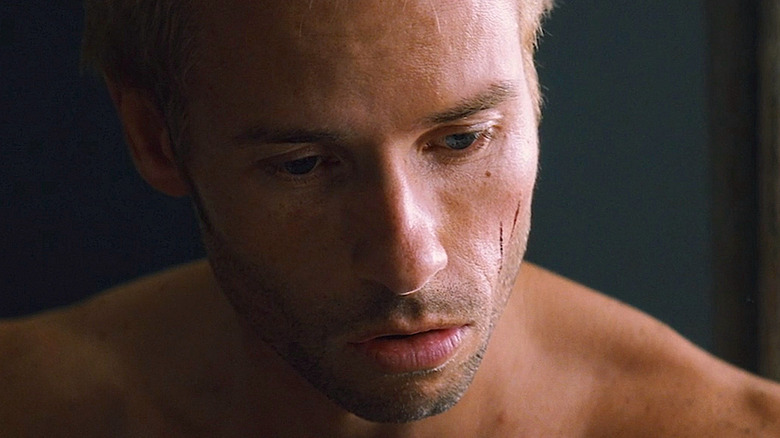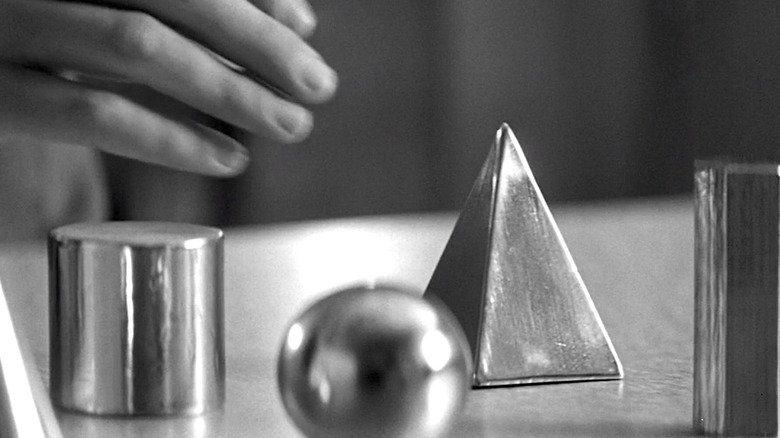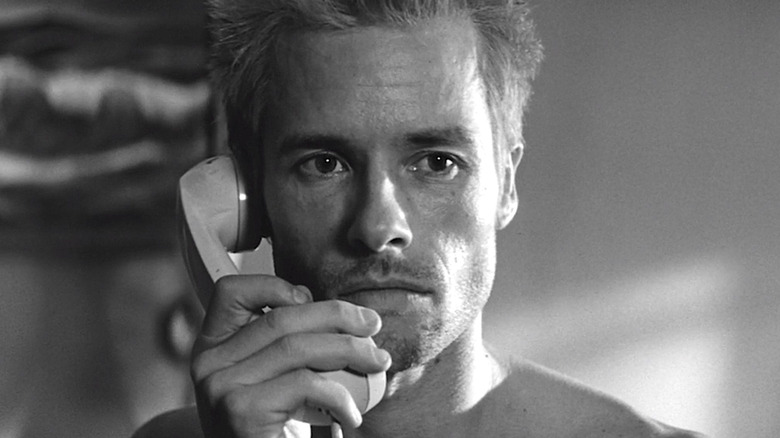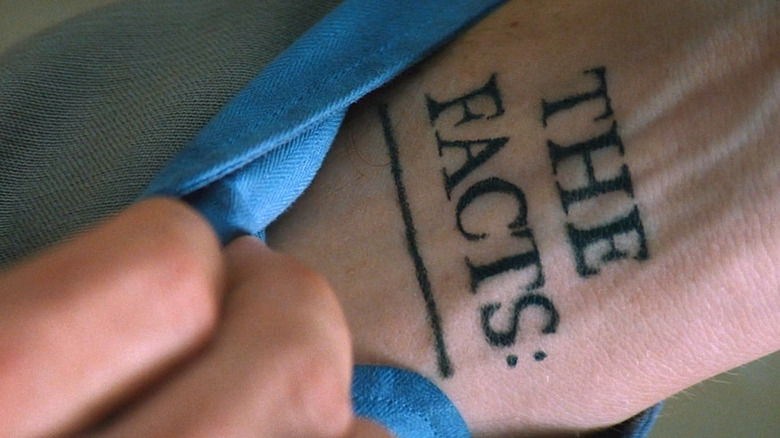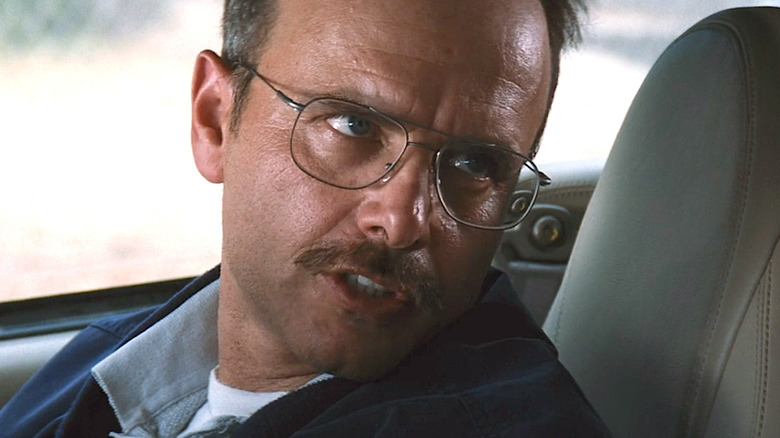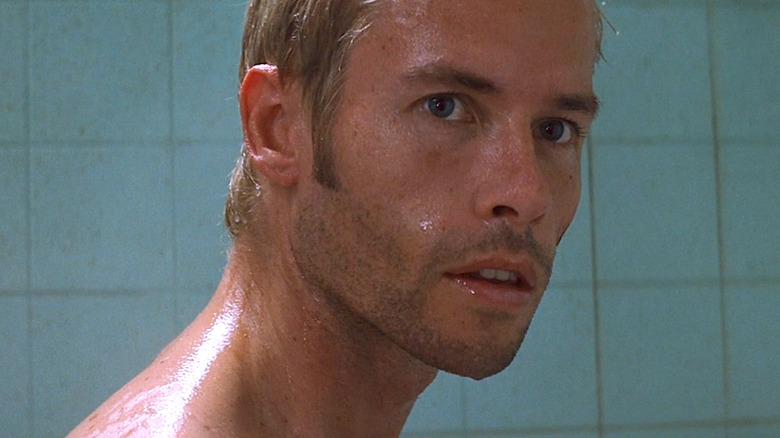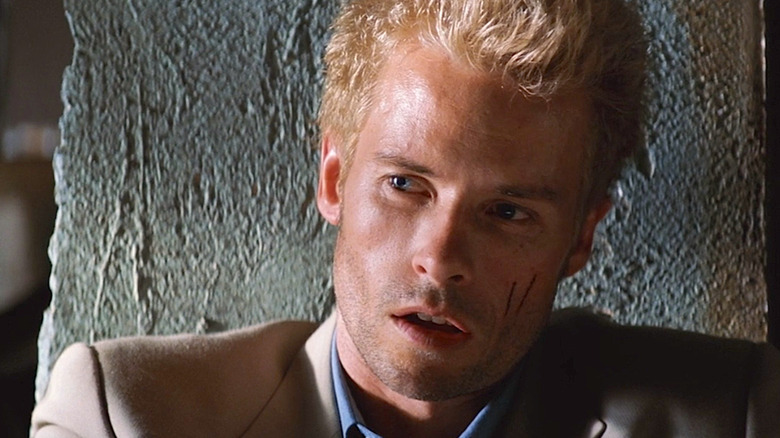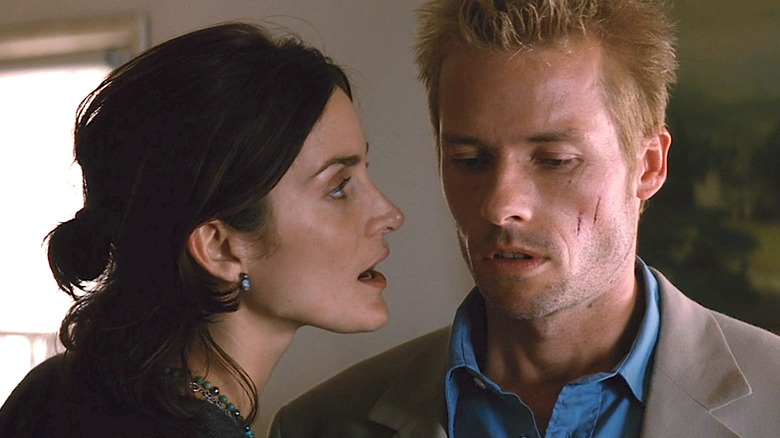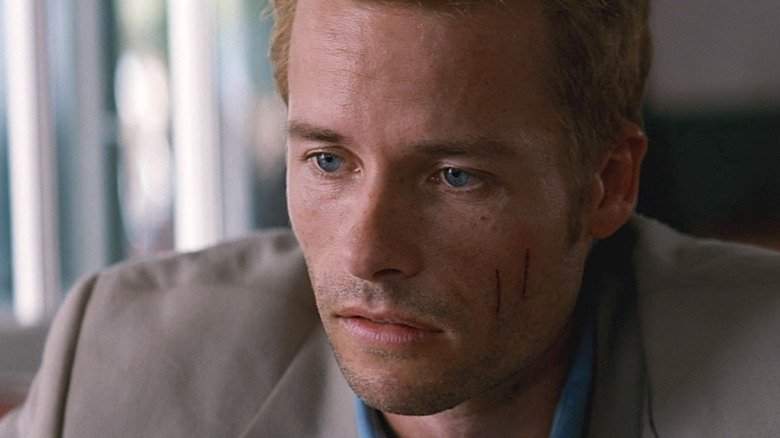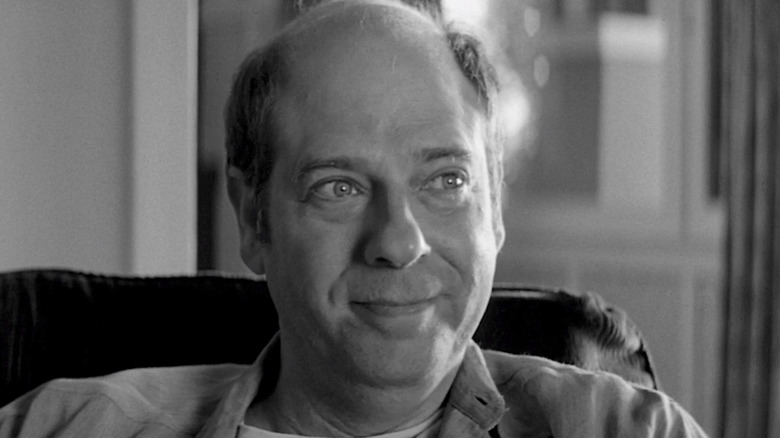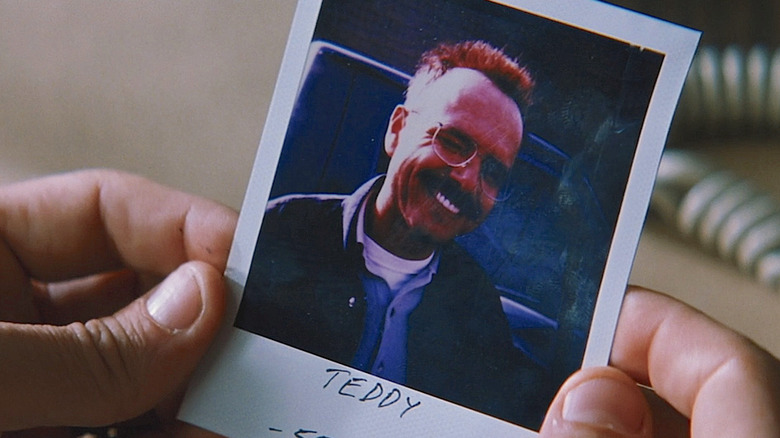Memento's Most Confusing Moments Explained
There are things you know for sure, and one of them is that "Memento" is among the trippiest thrillers of all time. This 2000 actioner explores the meaning of identity, the futility of revenge, and the power of loss — not that anyone picks up on all of that on a first viewing. What else would you expect from Christopher Nolan, who went on to direct "Inception," "Tenet," and "Interstellar"?
"Memento" stars Guy Pearce as Leonard Shelby, an amnesiac on a quest to track down the man who murdered his wife and stole his ability to make new memories. Joe Pantoliano plays Teddy, Leonard's buddy with a burning secret. Carrie-Ann Moss portrays the mysterious Natalie, a femme fatale in more ways than one. Much of the movie is told backwards, while some of it is not. All of it features flashbacks — and sometimes the flashbacks are faulty. This nonlinear feat of heart-pounding heartache holds up, more than 20 years after its debut — but you still might be baffled by its twists and turns, all these years later. Go get comfortable in a room at the Discount Inn, because we're here to explain the most confusing moments of "Memento."
12. What's up with the two timelines?
"Memento" opens in color, with Leonard Shelby shaking a bloody Polaroid. Instead of developing, the photo fades back to the white of a freshly-snapped shot. Faster than you can say "cult-hit indie darling," we get hit with the film's first trick: We've moved backwards, not forwards in time. Almost as soon as the realization registers, "Memento" cuts to an entirely different timeline, shot in black and white.
Christopher Nolan gave an elegant explanation of the two timelines to "Eyes on Cinema," describing the film's chronological kookiness as taking the shape of a hairpin. The black and white timeline is moving forward, while the events in color move in reverse. The two timelines meet at the end of the movie, which, of course, loops back into the beginning. While this timeline-jumping can make you more paranoid than Leonard Shelby after forgetting how much coffee he had this morning, Nolan insists that's the point. "We try to put you in his head and that's why the story is told backwards, because it denies the information that he's denying," the director remarked to IndieWire. The heightened subjectivity of "Memento" and its fractured timelines definitely scramble viewer's brains, but, like Leonard gains some form of clarity and agency by sticking to his system, attentive viewers gain understanding that they're witnessing slightly controlled chaos.
11. Why remember Sammy Jankis?
Why should we remember Sammy Jankis (Stephen Tobolowsky)? Who is Sammy Jankis? Why is Sammy Jankis tattoo-worthy? Sammy Jankis is the name of a patient Leonard really did deal with, back in his claim investigator days. He's also Leonard's proof that his anterograde amnesia is real and responsive to conditioning, while Sammy's was not.
Leonard desperately needs to believe there's a line between him and Sammy. Sammy didn't have a system, didn't take to conditioning, and ultimately never snapped out of his illness. Leonard needs to remember Sammy so he doesn't become Sammy. If he stays vigilant, conditioned, and in control of his memory loss, he won't accidentally kill his wife via insulin overdose and spend the rest of his days confused and in a home, as happened to Sammy. Leonard's heartbreaking realization about Sammy comes at the end of the movie, but Sammy's sad story is revealed in flashbacks throughout "Memento." The film is worth a rewatch, if only to remember Stephen Tobolowsky's gut-wrenching performance as Sammy Jankis.
10. Who is Leonard talking to on the phone?
"Memento" is a movie with few moments of orientation, but it does use some standard storytelling techniques to keep the audience's brains from totally breaking. Specifically, "Memento" indulges in some good old-fashioned exposition via phone call. Leonard Shelby's black-and-white calls might initially jar the viewer, but once a few take place, they provide brief relief from the main story. The calls act as a sort of stabilizing explainer for Leonard's system, a way for him to share memories of his own incident, and as a means of telling the tale of Sammy Jankis. The calls are almost refreshingly simple to process — until we remember Leonard's phone calls are unreliable. So who the heck is he talking to, and why?
Tired of searching your body for a tattoo reminding you of the answer? It's Teddy on the phone with Leonard. Sure, Leonard may pick up the wrong number a time or two, but Teddy is the only person in Leonard's life who knows how to keep him talking, and who has a reason to do so. While Leonard "learns" that Teddy is a cop helping him out with his case, Teddy is really keeping tabs on Leonard before and after Teddy manipulates him into solving his Jimmy problem. We can't help but wonder if Leonard (and a few drug dealers) would fare better in the days of caller ID.
9. How does Leonard's system work?
"You really do need a system," Leonard Shelby insists in "Memento." Indeed, what he lacks in short-term memory, he makes up for with his system. Leonard has particular pockets for particular items, a deep trust in his own handwriting, and a seemingly limitless budget for tattoos and Polaroid film. Without a system, Leonard warns in his assured, honeyed voice, someone like him could really be taken advantage of. Somehow, he learns to keep the pictures he snaps of friends, enemies, and his Jaguar in the right pockets. He endlessly repeats the truths he holds self-evident. He fights to muster control over his condition, just like Sammy Jankis could not.
Of course, Leonard both is and isn't in control. In the end, his system is revealed to be as fragile and binding as the lies any of us tell ourselves about who we are and what we're capable of. This is a poetic and painful truth. We can't help but wonder, though, how Leonard remembers his system if he can't make new memories. Why doesn't he forget the facts on the way to getting tattooed? What happens if he forgets he's being tattooed while he's being tattooed? These questions plague us like Leonard's quest for John G. plagues him — but such ambiguity is part of the movie's appeal.
8. How does Teddy know so much about Leonard?
Teddy is the one character in "Memento" with seemingly deep knowledge about Leonard. But how did Teddy get it? And why is Teddy always around, and obsessed with Leonard's Jag? Teddy turns up like a bad penny in Leonard's life, and seems to know Leonard better than he knows himself. While there's something to be said for Teddy's consistency, his timing and familiarity are unnerving — especially since we see Leonard kill him within the first 10 minutes of the movie.
Teddy's uncanny ability to pop up and holler "Lenny!" at pivotal moments shifts in tone throughout the film. At times, he seems sinister, like when he downplays the bullets in the abandoned pick-up truck, or tries to trick Leonard into trading cars. Other times, he seems genuinely concerned, like when he calls Natalie out as the manipulator she is. There's even a moment late in the film where dread mounts: Is Teddy the only person looking out for Leonard because Leonard has totally fabricated John G.? Did Leonard actually make a grave mistake by killing Teddy, his only guardian in the post-incident world?
The answer, in true Christopher Nolan fashion, is yes and no. Teddy knows about Leonard because he helped him with the original case involving Leonard and his wife. Teddy's been babysitting Leonard via phone and tracks him around town, worried that Jimmy's Jag and suit will tip off violent drug dealers. Teddy is half Leonard's guardian angel and half angel of death. Leonard manipulates his own memories to pursue justice, but Teddy manipulates Leonard to settle scores.
7. What really happened to Leonard and his wife?
Leonard Shelby is on a quest to avenge his wife, who he believes was raped and killed by the elusive John G. For much of the mind-bending run-time of "Memento," we believe the same. The story is the last new "old" memory Leonard has, and one of the only ones he can trust. But, like Leonard says to Teddy, "Memory's not perfect. It's not even that good." In Leonard's case, when it comes to this particular evening, his memory is devastatingly bad.
As the movie progresses, something becomes chillingly certain through flashbacks: There's more to Leonard's memory of the incident than he's able to accept. Initially, we get flashes of his wife smiling, getting a playful pinch, and then her face, wrapped in plastic. But as Teddy, Natalie, Dodd, and Jimmy agitate Leonard's carefully ordered system, we see flashes of new information in those old memories. The playful pinch becomes an insulin needle. Her eye opens. She isn't dead under that plastic — she's awake.
Here are the facts. That fateful night, Leonard and his wife were attacked by two men. Leonard killed one, but the other got away. His wife survived the night, but Leonard's memory didn't. Like Sammy's wife in Leonard's other core story, Leonard's wife killed herself by "testing" Leonard's condition. She was the one who needed insulin, and had Leonard inject her, over and over again. Wracked with grief and anterograde amnesia, Leonard tried to track down the second attacker when the cops didn't believe him. Of course, the only person who helps him is Teddy, a cop working Leonard's wife's case — and his own angle.
6. Why does Jimmy say Sammy?
"Remember Sammy Jankis" could be a tagline for "Memento." But why does Jimmy Grantz, the drug dealer Leonard kills, mention Sammy before he goes gentle into that good abandoned basement? How does Jimmy know Sammy's name? What does Jimmy knowing who Sammy Jankis is mean for the story?
If Jimmy knows the Sammy story, Leonard and the audience surmise, he must not be John G. There's no way Leonard would tell his wife's killer such an important story, right? It's a dreadful moment that casts doubt on both Jimmy's guilt and Leonard's system. It's all too plausible that he could have chatted with a killer on the phone, but that the desperate man Leonard is dragging around an abandoned building on Lincoln isn't the one he's after.
While the moment works to make Leonard shift his suspicion from Jimmy to Teddy, who pointed him in Jimmy's direction, it's also a bit confusing. When would Teddy have told Jimmy about Sammy? Or was it Burt, the link between the Discount Inn and Ferdy's Bar (where Jimmy dealt from), who passes on the Memory Guy's little story? This turning point snags Leonard a new target in Teddy, as well as a Jaguar and a snazzy new suit.
5. How does Natalie manipulate Leonard?
Natalie seems to be an intimate figure in Leonard's life, but she's really using him to do her dirty work. What is it, and why is she so comfortable tricking Leonard into carrying it out? Before you get too judgmental, ask yourself what you would do if Guy Pearce showed up in your ex's clothes, driving your ex's car, and willingly drank a beer you had another barfly hock a loogie into? We're just saying, maybe some of it is justified. Natalie is a femme fatale, mixed up with drug dealers and her own dead-end job. When Leonard breezes in wearing her boyfriend's look as a disguise, Natalie quickly assesses that Leonard is a dangerous man — one she can use to solve some of her problems. She trusts his "condition" is real (see: beer loogie) and gets to work "helping" Leonard with his wife's case.
But when Natalie pushes Leonard to kill for her, he refuses. Natalie taunts him into hitting her, mocking his condition and his wife. Leonard bloodies her face, and Natalie leaves. He desperately hunts for a pen to write down the truth before he forgets, but Natalie has hidden the pens from her pen cup. Leonard is out of luck. By the time she returns from her moment outside, Leonard has forgotten he's the one who roughed her up — and Natalie guilts him into offering to take care of Dodd for her — since following "Leonard's advice" got Dodd to threaten her. Think of the trouble saved if Leonard just invested in a lanyard pen.
4. Is Leonard's condition real?
Leonard talks a lot about his condition, but is his anterograde amnesia real? Was Sammy's? How does it all work? Anterograde amnesia, or short-term memory loss, is real, but rare. It often presents itself temporarily, or in tandem with retrograde amnesia, as with dementia patients. "Retrograde" amnesia means long-term memories are lost, while "anterograde" amnesia means new memories cannot be made or retained.
Neurologist and writer Oliver Sacks wrote about a man with memory issues very similar to Leonard and Sammy's in "The Man Who Mistook His Wife for a Hat." Here, Sacks details the life of a man named Jimmie R. who cannot form new memories. Sacks describes Jimmie as trapped in the unendingly present moment, surrounded by obliterating forgetfulness. Yikes. Whatever you do, don't lend Leonard a copy of this book — he'd probably end up burning it before reading it. Also, he would definitely forget to return it to you.
3. Why does Teddy help Leonard?
Chances are, if Joe Pantoliano is playing your buddy in a movie, he probably has ulterior motives. The list of slightly-to-majorly shady parts goes on and on: We've got Cypher in "The Matrix," the greedy bail bondsman who says "midnight run" in "Midnight Run," Francis Fratelli in "The Goonies," and many more. Naturally, then, it seems sketchy that Teddy spends so much time babysitting Leonard in "Memento." Surely it can't all be out of the goodness of Teddy's heart, right?
Right. Teddy is an undercover cop assigned to Leonard and his wife's case. While Leonard chases him to investigate the second attacker police don't think was on the scene, Teddy agrees to look into things. He tracks down the real John G., and Leonard kills him — then forgets he did the deed. Teddy sees an opportunity where Leonard fails to see he's gotten revenge. With some light manipulation and a lot of moral relativism, Teddy tricks Leonard into hunting drug dealers Teddy either wants to take down, or make some money off of. Leonard, meanwhile, gets to endlessly go on his quest for revenge. This way, Teddy kills countless birds with one stone — and that stone is named Leonard Shelby.
2. What's the real Sammy Jankis story?
As Leonard states in "Memento," "If we can't make memories, we can't heal." What we see in this film is a man who can't heal — and also a man who might think it's better to refuse to do so. Leonard craves meaning in his life despite his condition. Loss, and the impossible desire to regain what is missing, drive Leonard's actions. This ache to return to the past, contrasted with the experience of being trapped in a confusing present, is the heart of "Memento." It's a pretty relatable theme: The condition Leonard is afflicted with is anterograde amnesia, but it's also the human condition. Just like all good little humans, Leonard tells himself little lies to survive. Thus, his version of Sammy Jankis is born.
Sammy's real story is hard to pinpoint, but it's true that Leonard denied his claim back in his investigator days. Sammy, according to Teddy, didn't have a wife. Leonard uses Sammy as a storybook projection for some of his more painful memories. There are theories that Sammy is a total fabrication of Leonard's mind — "Memento" even slides a frame of Leonard into Sammy's home to further mess with viewers' minds. But the truth about Sammy is this: He's Leonard's coping mechanism. Leonard remembers Sammy Jankis so he can remember his wife without having to remember that he, in the grip of his condition, killed her.
1. Why does Leonard lie to himself?
Seeking revenge is like drinking poison and expecting the other guy to die, as the saying goes. But in the case of "Memento," Leonard Shelby doesn't remember what the poison tastes like, or how many other guys he's taken down. He's on an endless quest for revenge — at least until the movie's final (and first) John G. hits Leonard with a poison of his own: the truth.
Teddy tells Leonard the real deal behind Jimmy Grantz, the real John G., and all the fake ones in between. Leonard removed 12 pages from the initial police report on John G. so the puzzle would always need solving, and Leonard's new life would always have an old and powerful meaning. Leonard refuses to believe this last thing can still be taken from him. He also refuses to believe he's a cold-blooded killer. So what does he do? He betrays one last bit of trust — his own.
Leonard writes a new "truth" about Teddy down in his notes: He's the real John G. In his last bloom of awareness, Leonard lies to himself to keep his hope for revenge alive, and to mark Teddy for death. What happens after Leonard loses Teddy, though? Maybe this loss will break his system, and Leonard's last shot at meaning will be the one aimed at Teddy. Maybe Leonard's latest bit of self-deception will help him break free of the time loop he's trapped in. Only time can tell.

